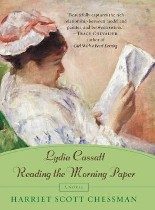 Harriet Scott Chessman •
Harriet Scott Chessman •
Lydia Cassatt Reading the Morning Paper •
I fell completely under the spell of this exquisite little book. Chessman’s poetic, understated language is perfectly calibrated to the delicacy of Mary Cassatt’s paintings.
The Cassatt family, American by birth, has settled in Paris: “The Cassatt Nation, small and besieged, at times, and independent.” Like her fellow Impressionists, Mary Cassatt works from life, recruiting friends and family to pose for her. Morning Paper imagines the intricate relationship between Mary (May) and older sister Lydia, her favorite model. “I can’t help wondering what she sees,” muses Lydia. “I’m as plain as a loaf of bread.” To her own mind, she is a little boat “bobbing along in the wake of [Mary’s] grander vessel.”
Lydia suffers from Bright’s disease, a painful kidney ailment. Despite her fragile health, she sits for a series of portraits that show her drinking tea, doing needlework, driving through the Bois de Boulogne, and reading. The simplicity of these commonplace actions is belied by the breathtaking beauty of their rendering, both in the five full-color plates that grace the text and in Chessman’s finely honed prose. Words and images alike shimmer with life.
May will continue painting for several more decades: “Her days glitter, round and new, like gold coins in a huge jar, filled almost to the brim, her only worry how to spend them.” Lydia will die at age 44, just over a year after the close of this novel, but she remains immortal and poignant on canvas. “Illness has this edge of grace. If the illness lifts, even for a few days, and one can enter the world again, all things shine with clarity and value. This cup, so light, becomes a miracle.”
Chessman’s ability to inhabit her subject’s skin and immerse us in the currents of her life constitutes another miracle.







Your email address will not be published.